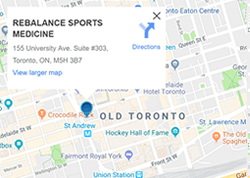The Importance of Having Strong Gluteals
 For many people in modern society the gluteal muscles (glutes) simply serve as a cushion to sit on all day, resulting in significant wasting and weakness. This blog post will aim to explain why this is such a big problem, outlining the function of the glutes and why they are so important in musculoskeletal health and injury prevention.
For many people in modern society the gluteal muscles (glutes) simply serve as a cushion to sit on all day, resulting in significant wasting and weakness. This blog post will aim to explain why this is such a big problem, outlining the function of the glutes and why they are so important in musculoskeletal health and injury prevention.
The glutes are comprised of three separate muscles including the gluteus maximus, the gluteus medius and the gluteus minimus. In the most basic sense, these muscles extend, abduct and rotate the hips. Functionally, the glutes counteract forces of gravity on the hip and trunk to allow for proper alignment during upright walking and running, minimizing excessive stress on joints and soft tissues.
While sitting, the glutes are placed in a lengthened position and are functionally turned off. After enough time of being in this stretched position, and without any exercise to strengthen these muscles, imbalances begin to form as the gluteal muscles get weaker and in some cases people forget how to use them. This negatively affects lower body alignment and function and is a root cause of many injuries. The following are just a few examples of how weak glutes can lead to injury:
- Low back pain: The glutes are responsible for helping to stabilize the low back during bending and lifting activities. Without strong glutes, the back extensor muscles are placed under more stress, as are the joints in the lumbar spine. This can lead to muscle strain, joint sprain or lumbar disc injuries.
- Anterior knee pain: The glutes are responsible for maintaining proper alignment of the hip and knee during single limb loading tasks such as walking, running and stair climbing. If the glutes are weak, oftentimes the hip and knee will start to rotate inwards, putting more pressure on the patellofemoral joint (the joint underneath the kneecap). After repetitive movements with poor alignment, pain, inflammation and even degeneration of the cartilage under the kneecap can occur.
- Hamstrings strains: The gluteus maximus is a strong hip extensor. If this muscle is too weak, the hamstrings will start to compensate. However, this can quickly lead to overuse of the hamstrings resulting in muscle strain or tendon injury.
So, what can you do to help keep your glutes from wasting away? First, try to spend less time sitting, and take frequent breaks from sitting. There are lots of different ways you can exercise your glutes, from squats, lunges and deadlifts, to running or taking the stairs. However, the key is to ensure you have proper alignment and control during whichever exercise you are doing to minimize risk of injury and to ensure you are targeting the right muscles. Your physiotherapist can help select appropriate exercises for your strength level, body type and functional or performance goals. They will also watch you doing the exercises to make sure you are doing them properly and feel comfortable with them before adding them to your home exercise or gym program. If you are concerned about your glute strength or just want to ensure you are on the right track to injury prevention, please feel free to contact us to book an appointment with one of our knowledgeable physiotherapists today.
Written By: Reanna Montopoli, FCAMPT Physiotherapist
Rebalance Toronto
Rebalance Sports Medicine is a multidisciplinary clinic in downtown Toronto offering physiotherapy, chiropractic, registered massage therapy, sports medicine, naturopathy, Pilates and more.



 What to Expect From Your First Physiotherapy Visit
What to Expect From Your First Physiotherapy Visit The Benefits of Fascial Stretch Therapy [Demo]
The Benefits of Fascial Stretch Therapy [Demo] How Does Physiotherapy Work?
How Does Physiotherapy Work? Best Exercises for Low Back Pain
Best Exercises for Low Back Pain